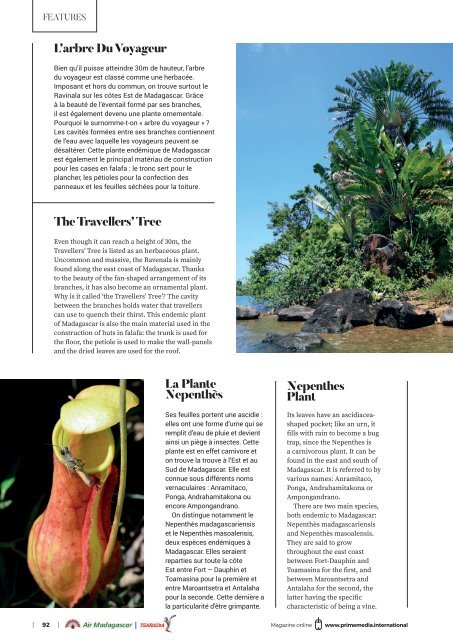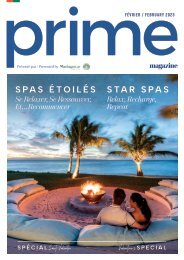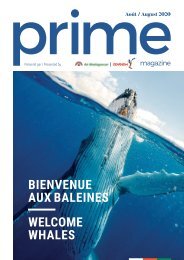Prime-Magazine-August-2019
You also want an ePaper? Increase the reach of your titles
YUMPU automatically turns print PDFs into web optimized ePapers that Google loves.
FEATURES<br />
L’arbre Du Voyageur<br />
Bien qu’il puisse atteindre 30m de hauteur, l’arbre<br />
du voyageur est classé comme une herbacée.<br />
Imposant et hors du commun, on trouve surtout le<br />
Ravinala sur les côtes Est de Madagascar. Grâce<br />
à la beauté de l’éventail formé par ses branches,<br />
il est également devenu une plante ornementale.<br />
Pourquoi le surnomme-t-on « arbre du voyageur » ?<br />
Les cavités formées entre ses branches contiennent<br />
de l’eau avec laquelle les voyageurs peuvent se<br />
désaltérer. Cette plante endémique de Madagascar<br />
est également le principal matériau de construction<br />
pour les cases en falafa : le tronc sert pour le<br />
plancher, les pétioles pour la confection des<br />
panneaux et les feuilles séchées pour la toiture.<br />
The Travellers’ Tree<br />
Even though it can reach a height of 30m, the<br />
Travellers’ Tree is listed as an herbaceous plant.<br />
Uncommon and massive, the Ravenala is mainly<br />
found along the east coast of Madagascar. Thanks<br />
to the beauty of the fan-shaped arrangement of its<br />
branches, it has also become an ornamental plant.<br />
Why is it called ‘the Travellers’ Tree’? The cavity<br />
between the branches holds water that travellers<br />
can use to quench their thirst. This endemic plant<br />
of Madagascar is also the main material used in the<br />
construction of huts in falafa: the trunk is used for<br />
the floor, the petiole is used to make the wall-panels<br />
and the dried leaves are used for the roof.<br />
La Plante<br />
Nepenthès<br />
Ses feuilles portent une ascidie :<br />
elles ont une forme d'urne qui se<br />
remplit d’eau de pluie et devient<br />
ainsi un piège à insectes. Cette<br />
plante est en effet carnivore et<br />
on trouve la trouve à l’Est et au<br />
Sud de Madagascar. Elle est<br />
connue sous différents noms<br />
vernaculaires : Anramitaco,<br />
Ponga, Andrahamitakona ou<br />
encore Ampongandrano.<br />
On distingue notamment le<br />
Nepenthès madagascariensis<br />
et le Nepenthès masoalensis,<br />
deux espèces endémiques à<br />
Madagascar. Elles seraient<br />
reparties sur toute la côte<br />
Est entre Fort – Dauphin et<br />
Toamasina pour la première et<br />
entre Maroantsetra et Antalaha<br />
pour la seconde. Cette dernière a<br />
la particularité d'être grimpante.<br />
Nepenthes<br />
Plant<br />
Its leaves have an ascidiaceashaped<br />
pocket; like an urn, it<br />
fills with rain to become a bug<br />
trap, since the Nepenthes is<br />
a carnivorous plant. It can be<br />
found in the east and south of<br />
Madagascar. It is referred to by<br />
various names: Anramitaco,<br />
Ponga, Andrahamitakona or<br />
Ampongandrano.<br />
There are two main species,<br />
both endemic to Madagascar:<br />
Nepenthès madagascariensis<br />
and Nepenthès masoalensis.<br />
They are said to grow<br />
throughout the east coast<br />
between Fort-Dauphin and<br />
Toamasina for the first, and<br />
between Maroantsetra and<br />
Antalaha for the second, the<br />
latter having the specific<br />
characteristic of being a vine.<br />
| 92 | <strong>Magazine</strong> online www.primemedia.international

















